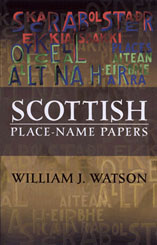
 | Scottish Place-Name Papers William J Watson |
| sample extract... | |
Although much has been written about our Scottish names of places, we are as yet very far from possessing anything like a complete or satisfactory account of them. Nothing on the subject so far approaches, for example, the work of Dr Joyce on the names of Ireland, or that of Canon Isaac Taylor on English Village Names. This may be ascribed partly to the great difficulty of the subject, aggravated as it is by the comparative scantiness of ancient and reliable written forms of names, partly to the fewness of investigators possessing the necessary qualifications of scholarship and opportunity. It must be admitted, however, that much of the work actually attempted is sadly lacking in trustworthiness from no other reason than defective method; and the remarks that follow are intended mainly to set forth some principles that the writer, and others of greater experience than he can claim, have found trustworthy and helpful in the study of names which occur in districts where Gaelic is still vernacular. There, with care and right methods, it is possible to attain a high degree of certainty in interpretation; in districts where Gaelic has long died out, and where, accordingly, our sole data are old spellings and modern English pronunciations, the case is different. In dealing with the names of a Gaelic-speaking district the first duty of the investigator is to ascertain with accuracy the native Gaelic pronunciation. For small areas this is a comparatively easy matter; when one has to deal with the names of a whole Highland county it becomes formidable. Very little can be done by correspondence, unless one is fortunate enough to have as correspondent an expert in Gaelic spelling; and though Gaelic spelling is not really difficult, such experts are not to be met in every district. By far the most satisfactory way is to verify the names personally on the spot; thus variations may be checked; the places themselves can be inspected -- always an advantage; in addition, one picks up names of interest not found on the maps, as well as local lore in the shape of topographical rhymes and other items of Dinnsenchas. Incidentally one becomes acquainted with local peculiarities of dialect, which is not seldom a matter of some importance. It is obvious that to deal with the whole of the Highlands in this manner is beyond the capacity of one man, unless he be endowed with exceptional enthusiasm and leisure. Even with the advantage of generous assistance it took the present writer quite four years to verify the mainland names of his native county of Ross, and another survey of the ground would doubtless bring much new material to light. There is therefore in our Highland counties ample room for many investigators, who may render inestimable service to the study of topography by simply writing down in orthodox Gaelic spelling the names as they are heard on the lips of natives. It is only after such a process of verification that we are in direct touch with the name itself as distinguished from Anglified corruptions or mere map forms. A good example of an Anglified form is the well-known Altnaharra in Sutherland. As to this name, quot homines, tot sententiae. It has been explained as Harold's Burn; Burn of the Heights (cf Harris, in Gaelic na Hearradh); Stream with the pillar or rock (carragh); Stream of slaughter (marbhadh); and so on. But one and all carefully avoid the genuine Gaelic form, which is Allt na h-Eirbhe (given by the Andersons in 1834 as Aultnaharrou or Aultnaherve), involving the old Gaelic word eirbhe, a wall of turf and stones; O. Ir. airbe, a fence (primarily 'ribs'). In point of fact the old wall is there; a long wall across moor and hill, worth the attention of antiquaries. |
|